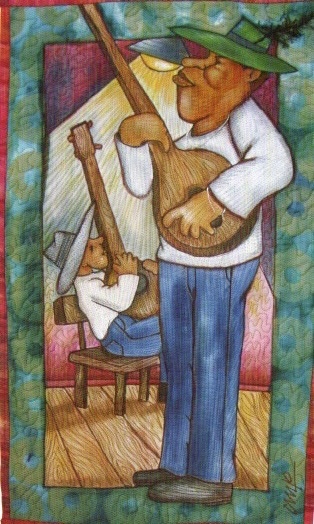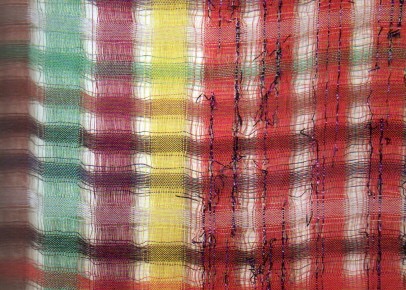Preamble
Art Quilts have featured on this blogspot and so for your convenience I have listed below previous posts in this series:
Art Quilts - Part I
Art Quilts - Part II
Art Quilts - Part III
Art Quilts - Part IV
Art Quilts - Part V
Art Quilts - Part VI
Art Quilts - Part VII
Art Quilters of the Netherlands - Part I
Art Quilters of the Netherlands - Part II
Art Quilters of the Netherlands - Part III
Four Selected European Art Quilters - Part I
Four Selected European Art Quilters - Part II
Four Selected European Art Quilters - Part III
Art Quilts of Jane Sassaman
Art Quilts of Michael A. Cummings
Four Selected European Art Quilters - Part IV
Art Quilts of Carolyn Crump
Jan Myers-Newbury
Art Quilts of Karin Franzen
Art Quilts of Carolyn Crump [1]
A fifth-generation quilter, who has also studied painting and graphic design, Carolyn Crump draws on a variety of media to create vivid, richly textured portraits and scenes. Block prints or linocuts, her figures are outlined in black against boldly colored backgrounds. Lively and dynamic, the black lines of each figure create a sense of movement that Crump echoes in images like flowing scarves, billowing ribbons, and flags etc.
Title: Cherished Times (2007).
Materials and Techniques: Cotton; appliquéd, machine sewn.
Size: 38 x 34 inches (96.5 x 86.4 cm).
Photograph: Courtesy of the artist.
Close up view of the above image.
Title: African Attitude (2009).
Materials and Techniques: Cotton; painted, machine sewn.
Size: 19 x 17 inches (48.2 x 43.2 cm).
Photograph: Courtesy of Ash Wilson.
Close up view of the above image.
Title: The Kiss (2009).
Materials and Techniques: Cotton, silk; appliquéd, machine sewn.
Size: 14.5 x 10 inches (36.8 x 25.4 cm).
Photograph: Courtesy of Ash Wilson.
Title: Awakening Spring (2007).
Materials and Techniques: Cotton; glass beads; appliquéd, machine sewn, hand sewn.
Size: 52.5 x 34 inches (1.3 x 0.8 cm).
Photograph: Courtesy of Rodolfo Hernandez.
Artist's Comment[1]: I like challenging myself to be better. When I fail at one process, I don't stop until I find a solution.
Close up view of the above image.
Title: Dichotomy (2009).
Materials and Techniques: Cotton; appliquéd, machine sewn.
Size: 31 x 18 inches (78.7 x 45.7 cm).
Photograph: Courtesy of Ash Wilson.
Title: Wings of Faith (2008).
Materials and Techniques: Cotton; appliquéd, machine sewn.
Size: 28 x 26 inches (71.7 x 66 cm).
Photograph: Courtesy of Rick Stein.
Artist's Comment [1]: The medium of fiber draws me into a world of unlimited imagination.
Close up view of the above image.
Title: Like Father, Like Son (2009).
Materials and Techniques: Cotton; paint; appliquéd, machine sewn.
Size: 26 x 16 inches (66 x 40.6 cm).
Photograph: Courtesy of Ash Wilson.
Close up view of the above image.
Title: Dusky Cove (2007).
Materials and Techniques: Cotton; appliquéd, machine sewn.
Size: 38 x 53 inches (0.9 x 1.3 m).
Photograph: Courtesy of Ash Wilson.
Title: Spirit of Rita (2006).
Materials and Techniques: Cotton; buttons, appliquéd, machine sewn.
Size: 40.5 x 54 inches (1 x 1.4 m).
Photograph: Courtesy of Ash Wilson.
Title: Playing the Blues (2008).
Materials and Techniques: Cotton; appliquéd, machine sewn.
Size: 14 x 10 inches (35.6 x 25.4 m).
Photograph: Courtesy of Ash Wilson.
Artist's Comment [1]: Quilting gives me the opportunity to express what I imagine, to materialize it on a surface for others to see.
Reference:
[1] Masters: Art Quilts, Vol. 2, Curated by M. Sielman, Lark Crafts, An Imprint of Sterling Publishing Co., Inc., New York (2011).
Art Quilts have featured on this blogspot and so for your convenience I have listed below previous posts in this series:
Art Quilts - Part I
Art Quilts - Part II
Art Quilts - Part III
Art Quilts - Part IV
Art Quilts - Part V
Art Quilts - Part VI
Art Quilts - Part VII
Art Quilters of the Netherlands - Part I
Art Quilters of the Netherlands - Part II
Art Quilters of the Netherlands - Part III
Four Selected European Art Quilters - Part I
Four Selected European Art Quilters - Part II
Four Selected European Art Quilters - Part III
Art Quilts of Jane Sassaman
Art Quilts of Michael A. Cummings
Four Selected European Art Quilters - Part IV
Art Quilts of Carolyn Crump
Jan Myers-Newbury
Art Quilts of Karin Franzen
Art Quilts of Carolyn Crump [1]
A fifth-generation quilter, who has also studied painting and graphic design, Carolyn Crump draws on a variety of media to create vivid, richly textured portraits and scenes. Block prints or linocuts, her figures are outlined in black against boldly colored backgrounds. Lively and dynamic, the black lines of each figure create a sense of movement that Crump echoes in images like flowing scarves, billowing ribbons, and flags etc.
Title: Cherished Times (2007).
Materials and Techniques: Cotton; appliquéd, machine sewn.
Size: 38 x 34 inches (96.5 x 86.4 cm).
Photograph: Courtesy of the artist.
Close up view of the above image.
Title: African Attitude (2009).
Materials and Techniques: Cotton; painted, machine sewn.
Size: 19 x 17 inches (48.2 x 43.2 cm).
Photograph: Courtesy of Ash Wilson.
Close up view of the above image.
Title: The Kiss (2009).
Materials and Techniques: Cotton, silk; appliquéd, machine sewn.
Size: 14.5 x 10 inches (36.8 x 25.4 cm).
Photograph: Courtesy of Ash Wilson.
Title: Awakening Spring (2007).
Materials and Techniques: Cotton; glass beads; appliquéd, machine sewn, hand sewn.
Size: 52.5 x 34 inches (1.3 x 0.8 cm).
Photograph: Courtesy of Rodolfo Hernandez.
Artist's Comment[1]: I like challenging myself to be better. When I fail at one process, I don't stop until I find a solution.
Close up view of the above image.
Title: Dichotomy (2009).
Materials and Techniques: Cotton; appliquéd, machine sewn.
Size: 31 x 18 inches (78.7 x 45.7 cm).
Photograph: Courtesy of Ash Wilson.
Title: Wings of Faith (2008).
Materials and Techniques: Cotton; appliquéd, machine sewn.
Size: 28 x 26 inches (71.7 x 66 cm).
Photograph: Courtesy of Rick Stein.
Artist's Comment [1]: The medium of fiber draws me into a world of unlimited imagination.
Close up view of the above image.
Title: Like Father, Like Son (2009).
Materials and Techniques: Cotton; paint; appliquéd, machine sewn.
Size: 26 x 16 inches (66 x 40.6 cm).
Photograph: Courtesy of Ash Wilson.
Close up view of the above image.
Title: Dusky Cove (2007).
Materials and Techniques: Cotton; appliquéd, machine sewn.
Size: 38 x 53 inches (0.9 x 1.3 m).
Photograph: Courtesy of Ash Wilson.
Title: Spirit of Rita (2006).
Materials and Techniques: Cotton; buttons, appliquéd, machine sewn.
Size: 40.5 x 54 inches (1 x 1.4 m).
Photograph: Courtesy of Ash Wilson.
Title: Playing the Blues (2008).
Materials and Techniques: Cotton; appliquéd, machine sewn.
Size: 14 x 10 inches (35.6 x 25.4 m).
Photograph: Courtesy of Ash Wilson.
Artist's Comment [1]: Quilting gives me the opportunity to express what I imagine, to materialize it on a surface for others to see.
Reference:
[1] Masters: Art Quilts, Vol. 2, Curated by M. Sielman, Lark Crafts, An Imprint of Sterling Publishing Co., Inc., New York (2011).





















































